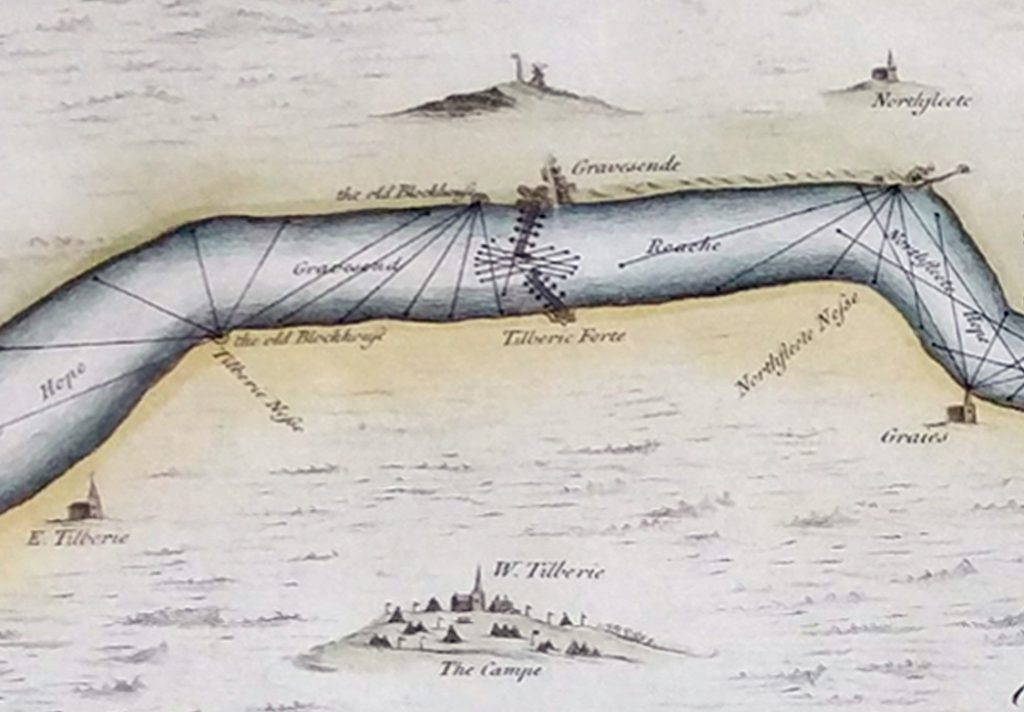East Tilbury Blockhouse was a Device Fort, constructed in 1539 to protect the River Thames. It was disarmed in 1553, and soon fell out of use. Eroded by the river, its former site is now occupied by the 18th-century Coalhouse Fort.
History
In 1533, King Henry VIII broke with Pope Paul III in order to annul the long-standing marriage to his wife, Catherine of Aragon, and remarry. Catherine was the aunt of Charles V, the Holy Roman Emperor, and he took the annulment as a personal insult. This resulted in France and the Empire declaring an alliance against Henry in 1538, and the Pope encouraging the two countries to attack England. An invasion of England appeared certain. In response, Henry issued an order, called a “device”, in 1539, giving instructions for the “defence of the realm in time of invasion” and the construction of forts along the English coastline.
The River Thames was strategically important, as the city of London and the newly constructed royal dockyards of Deptford and Woolwich were vulnerable to seaborne attacks arriving up the estuary, which was a major maritime route, carrying 80 percent of England’s exports. At the mouth of the estuary, the Thames narrowed considerably, forming a natural hub for communications: the “Long Ferry” took passengers into the capital, and the “Cross Ferry” moved traffic across the river. This was also the first point that an invasion force would be able to easily disembark along the Thames, as before this point the mudflats along the sides of the estuary would have made landings difficult. Temporary defences had been constructed at Tilbury as early as the 14th and 15th centuries, although little is known about their design.


Under the King’s new programme of work in 1539, the Thames was protected with a mutually reinforcing network of blockhouses at Gravesend, Milton, and Higham on the south side of the river, and West and East Tilbury on the opposite bank.
East Tilbury Blockhouse was probably D-shaped, with a circular bastion facing the river and additional battery positions on both sides of the main defences, built using stone and timber taken from St Margaret’s Chantry. It was recorded as having fifteen iron and brass cannon of various calibres in 1540; these had been increased to 27 by 1539–40. It had a small permanent garrison, consisting of a commander and his deputy, a porter, two soldiers and four gunners. The blockhouse’s design may have been altered in 1545.
The invasion threat passed and in 1553 all of the blockhouses were ordered to return their guns; Milton and Higham were demolished. In the summer of 1588, there was a fresh threat of invasion by the Spanish Armada, but by then East Tilbury had already probably fallen out of use. By 1735, the site it had been inundated by the Thames and was in ruins.
In the 18th and 19th centuries, Coalhouse Fort was built just inshore from the blockhouse, the remains of which may still survive under the estuary mud.
Bibliography
- Biddle, Martin; Hiller, Jonathon; Scott, Ian; Streeten, Anthony (2001). Henry VIII’s Coastal Artillery Fort at Camber Castle, Rye, East Sussex: An Archaeological Structural and Historical Investigation. Oxford, UK: Oxbow Books. ISBN 0904220230.
- Cruden, Robert Peirce (1843). The History of the Town of Gravesend. London, UK: William Pickering. OCLC 4773453.
- Hale, J. R. (1983). Renaissance War Studies. London, UK: Hambledon Press. ISBN 0907628176.
- Harrington, Peter (2007). The Castles of Henry VIII. Oxford, UK: Osprey Publishing. ISBN 9781472803801.
- Kent Council (2004). Gravesend – Kent, Archaeological Assessment Document. Maidstone, UK: Kent Council and English Heritage.
- Moore, Peter (1990). Tilbury Fort: A Post-Medieval Fort and its Inhabitants. London, UK: Newham Museum Service.
- Morley, B. M. (1976). Henry VIII and the Development of Coastal Defence. London, UK: Her Majesty’s Stationery Office. ISBN 0116707771.
- Osborne, Mike (2013). Defending Essex: The Military Landscape from Prehistory to the Present. Stroud, UK: The History Press. ISBN 9780752488349.
- Smith, Victor T. C. (1974). “The Artillery Defences at Gravesend”. Archaeologia Cantiana. 89: 141–168.
- Smith, Victor (1980). “The Milton Blockhouse, Gravesend: Research and Excavation”. Archaeologia Cantiana. 96: 341–362.
- Walton, Steven A. (2010). “State Building Through Building for the State: Foreign and Domestic Expertise in Tudor Fortification”. Osiris. 25 (1): 66–84.
Attribution
The text of this page was adapted from “Tilbury Fort” and “Coalhouse Fort” on the English language website Wikipedia, as the version dated 29 September 2018, and accordingly the text of this page is licensed under CC BY-SA 3.0. Principal editors have included Hchc2009, Prioryman, Alansplodge, Rjm at sleeper and Mark.murphy , and the contributions of all editors can be found on the history tab of the Wikipedia articles.
